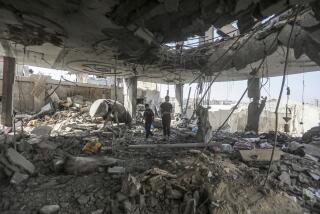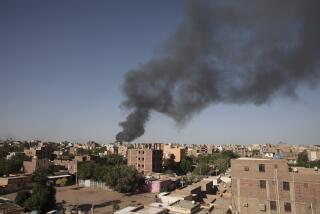U.S. Rescue Mission in Rwanda Would Pose High-Risk Problems
- Share via
WASHINGTON — The United States would face high-risk tactical and logistic problems in trying to mount a military rescue operation to evacuate about 255 Americans trapped in Rwanda, defense analysts said Friday.
The biggest difficulty would be determining how to get a sizable enough contingent there quickly. The only U.S. military forces near Rwanda are about 2,200 Marines aboard the amphibious assault ship Peleliu now sailing off the coast of Somalia.
But Rwanda, which is inland and several hundred miles from the Indian Ocean, cannot be reached by means of an amphibious landing and is too far from the coast for the Marines to get there by helicopter.
As a result, analysts said, the most likely option would be to send Army special forces units, flown in either from Nairobi or Mombasa, to staging areas in neighboring Kenya.
But that kind of operation might not be as simple as it sounds, experts said.
For one thing, it remained unclear whether the airport at Kigali, the Rwandan capital, is secure enough for U.S. troops to land. If it is not, the operation could require an advance assault by parachute-borne Ranger troops, who would have to be deployed from somewhere in Europe, to seize the airport forcibly.
Once the airport is secure, regular Army units could be flown in.
Col. Harry Summers, a former Pentagon strategist, suggested that U.S. rescue forces might not meet any opposition. “Normally, these people wouldn’t want war with the U.S.,” he said. “They’d probably just let us go.”
But if the Rwandans decided to mount a defense--or if guerrilla troops chose to impede U.S. forces with sniper fire--it could add substantially to the difficulty, military experts said.
In that case, the U.S. special forces troops could be facing house-to-house fighting in a city that is unfamiliar to U.S. units. “It could get really nasty,” Summers said.
There are no U.S. military forces in Rwanda. By agreement between the two countries, the American Embassy in the capital city of Kigali is guarded by Rwandan troops, not U.S. Marines. Complicating the situation, dozens of non-Americans have taken refuge in the U.S. Embassy.
Analysts said that any rescue operation probably would be carried out by light infantry units, using only Humvee vehicles and perhaps some light trucks. No tanks or artillery would be needed.
The United States could also send AC-130H Spectre gunships, equipped with precision-guided cannon that are especially effective in supporting ground operations.
At the same time, the Pentagon probably would coordinate its moves with French and Belgian military commanders, with whom it was consulting late Friday. Military forces from both countries have broad experience in the region.
If Belgian or French forces were used, the U.S. military almost certainly would provide the long-range airlift to transport them to Rwanda. Neither Belgium nor France has sufficient airlift power to do the job, military analysts said.
Analysts said a rescue effort in Rwanda would contrast sharply with other similar operations in recent years. In the 1990 evacuation of Americans from Liberia, for example, the job was handled easily by a Marine Expeditionary Unit, which was able to stage an amphibious landing because Liberia is on the African coast. In Grenada, in 1983, the rescue effort was made simpler because Grenada is an island and because it was easy to secure the airport, enabling the Army to send troops en masse.
More to Read
Sign up for Essential California
The most important California stories and recommendations in your inbox every morning.
You may occasionally receive promotional content from the Los Angeles Times.












